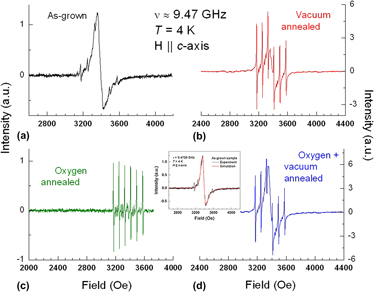Crossref Citations
This article has been cited by the following publications. This list is generated based on data provided by
Crossref.
Nori, Sudhakar
Yang, T. -H.
and
Narayan, Jagdish
2011.
VO2 thin films: Defect mediation in room temperature ferromagnetic switching characteristics.
JOM,
Vol. 63,
Issue. 10,
p.
29.
Kan, E. J.
Wu, Fang
Wu, Haiping
Xiao, Chuanyun
Xiang, Hongjun
and
Deng, Kaiming
2013.
d magnetism in semiconductors through confining delocalized atomic orbitals.
Applied Physics Letters,
Vol. 102,
Issue. 2,
Molaei, R.
Bayati, R.
Nori, S.
Kumar, D.
Prater, J. T.
and
Narayan, J.
2013.
Diamagnetic to ferromagnetic switching in VO2 epitaxial thin films by nanosecond excimer laser treatment.
Applied Physics Letters,
Vol. 103,
Issue. 25,
Bayati, M. R.
Joshi, S.
Molaei, R.
Narayan, R. J.
and
Narayan, J.
2013.
Ultrafast switching in wetting properties of TiO2/YSZ/Si(001) epitaxial heterostructures induced by laser irradiation.
Journal of Applied Physics,
Vol. 113,
Issue. 6,
Molaei, R.
Bayati, M. R.
Alipour, H. M.
and
Narayan, J.
2013.
Controlled epitaxial integration of polar ZnO(0001) with Si(001).
Applied Physics Letters,
Vol. 102,
Issue. 10,
Bayati, M. R.
Alipour, H. M.
Joshi, S.
Molaei, R.
Narayan, R. J.
Narayan, J.
and
Misture, S. T.
2013.
Thin-Film Epitaxy and Enhancement of Photocatalytic Activity of Anatase/Zirconia Heterostructures by Nanosecond Excimer Laser Treatment.
The Journal of Physical Chemistry C,
Vol. 117,
Issue. 14,
p.
7138.
Molaei, R.
Bayati, M. R.
Alipour, H. M.
Nori, S.
and
Narayan, J.
2013.
Enhanced photocatalytic efficiency in zirconia buffered n-NiO/p-NiO single crystalline heterostructures by nanosecond laser treatment.
Journal of Applied Physics,
Vol. 113,
Issue. 23,
Xu, Xiaoyong
Xu, Chunxiang
Chen, Guofeng
Wu, Jing
and
Hu, Jingguo
2013.
Role of zinc vacancies in driving ferromagnetism in undoped ZnO granular films.
EPL (Europhysics Letters),
Vol. 101,
Issue. 2,
p.
27009.
Molaei, R
Bayati, M R
Alipour, H M
Estrich, N A
and
Narayan, J
2014.
Nanosecond laser switching of surface wettability and epitaxial integration ofc-axis ZnO thin films with Si(111) substrates.
Journal of Physics: Condensed Matter,
Vol. 26,
Issue. 1,
p.
015004.
Gharagozlou, Mehrnaz
and
Bayati, R.
2014.
Photocatalytic activity and formation of oxygen vacancies in cation doped anatase TiO2 nanoparticles.
Ceramics International,
Vol. 40,
Issue. 7,
p.
10247.
Bayati, R.
Molaei, R.
Richmond, A.
Nori, S.
Wu, F.
Kumar, D.
Narayan, J.
Reynolds, J. G.
and
Reynolds, C.L.
2014.
Modification of Properties of Yttria Stabilized Zirconia Epitaxial Thin Films by Excimer Laser Annealing.
ACS Applied Materials & Interfaces,
Vol. 6,
Issue. 24,
p.
22316.
Abd Aziz, Siti Nor Qurratu Aini
Pung, Swee-Yong
Ramli, Nurul Najiah
and
Lockman, Zainovia
2014.
Growth of ZnO Nanorods on Stainless Steel Wire Using Chemical Vapour Deposition and Their Photocatalytic Activity.
The Scientific World Journal,
Vol. 2014,
Issue. ,
p.
1.
Moatti, Adele
Bayati, Reza
Singamaneni, Srinivasa Rao
and
Narayan, Jagdish
2016.
Thin film bi-epitaxy and transition characteristics of TiO2/TiN buffered VO2 on Si(100) substrates.
MRS Advances,
Vol. 1,
Issue. 37,
p.
2635.
Singamaneni, Srinivasa Rao
Prater, John Thomas
and
Narayan, Jagdish
2016.
Multifunctional epitaxial systems on silicon substrates.
Applied Physics Reviews,
Vol. 3,
Issue. 3,
p.
031301.
Yousaf, Ammar Bin
Imran, M.
Zaidi, Syed Javaid
and
Kasak, Peter
2017.
Highly Efficient Photocatalytic Z-Scheme Hydrogen Production over Oxygen-Deficient WO3–x Nanorods supported Zn0.3Cd0.7S Heterostructure.
Scientific Reports,
Vol. 7,
Issue. 1,
Yu, Tzu-Yi
Wei, Min Ruei
Weng, Chen Yuan
Su, Wei Ming
Lu, Chien Cheng
Chen, Yu Tzu
and
Chen, Hsiang
2017.
Modulating the size of ZnO nanorods on SiO2 substrates by incorporating reduced graphene oxide into the seed layer solution.
AIP Advances,
Vol. 7,
Issue. 6,
Van Khai, Tran
Van Thu, Le
Ha, La Thi Thai
Thanh, Vu Minh
and
Lam, Tran Dai
2018.
Structural, optical and gas sensing properties of vertically well-aligned ZnO nanowires grown on graphene/Si substrate by thermal evaporation method.
Materials Characterization,
Vol. 141,
Issue. ,
p.
296.
Awan, Saif Ullah
Hasanain, S.K.
Rashid, Jamshaid
Hussain, Shahzad
Shah, Saqlain A.
Hussain, Mian Zahid
Rafique, Mohsin
Aftab, M.
and
Khan, Rashid
2018.
Structural, optical, electronic and magnetic properties of multiphase ZnO/Zn(OH) 2 /ZnO 2 nanocomposites and hexagonal prism shaped ZnO nanoparticles synthesized by pulse laser ablation in Heptanes.
Materials Chemistry and Physics,
Vol. 211,
Issue. ,
p.
510.
Huang, Wen-Chang
Chiu, Jo Lun
Lin, Xin Dai
Lin, Yu Ching
Tsai, Shin Chieh
Su, Wei Ming
Weng, Chen Yuan
Lu, Chien Cheng
Lin, Chia Feng
and
Chen, Hsiang
2018.
Tuning the rod diameter of ZnO nanorods on porous silicon by incorporating graphene.
Results in Physics,
Vol. 10,
Issue. ,
p.
132.
Sun, Xiaomao
Wang, Kedian
Fan, Zhengjie
Wang, Rujia
Mei, Xuesong
and
Lu, Yang
2021.
Regulation of hydrophobicity on yttria stabilized zirconia surface by femtosecond laser.
Ceramics International,
Vol. 47,
Issue. 7,
p.
9264.





